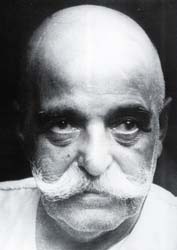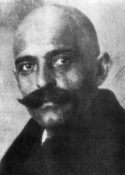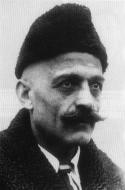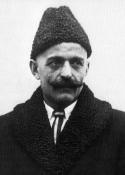

George Ivanovitch Gurdjieff was born in Alexandropol in Russian Armenia in 1866, though there are doubts about the precise date. He died in Paris in 1949. The details of his early life are drawn mainly from his autobiographical sketches which are reputed to be a little 'impressionistic'. There is also a missing period of about twenty years from 1887 to 1907, which would include his early thirties, the age where the transformation of an individual to an enlightened Master is most common. Gurdjieff came to fame in Paris in the 1920s as a spiritual teacher, though this was after adventures and teachings in Moscow, Essentuki and Tbilisi. Although these adventures were real enough, Gurdjieff created a mythic personality for himself which led to the occasional charge of charlatanry. Apart from the controversial nature of his life and teachings, Gurdjieff's spiritual history is unusual for the way that it involved important figures in the spiritual life of Europe and America in the first half of the 20th century. These include P.D.Ouspensky (philosopher and author of 'Tertium Organum', J.G.Bennett (author and founder of many spiritual movements in Britain), Thomas de Hartmann (composer), A.R.Orage (editor of New Age in the 1920s) and many other writers, artists and thinkers of his time.
Gurdjieff travelled extensively in the first part of his life, and always claimed that his teachings derived from contact with Masters in remote and hidden parts of the middle and far East, including Iraq and Tibet. These sources have never been conclusively traced but show strong Sufi influences. His emergence as a spiritual teacher took place in Russia before the first world war, where he met some of his best known pupils including Ouspensky and the de Hartmanns. He also worked on his first production, The Struggle of the Magicians, indicative of his life-long interest in dance and drama as a vehicle for spiritual teachings. When war broke out he undertook hazardous journeys with his first group of disciples, settling in Tbilisi (capital of Georgia), where the group immediately staged new productions of the Sacred Dances. This involved the contribution of dance teacher Madame de Salzmann, who continued the work long past Gurdjieff's death, and who can be seen instructing pupils in films of the Dances, including the motion picture 'Meetings with Remarkable Men.'
In Tbilisi Gurdjieff set up the first 'Institute for the Harmonious Development of Man', but the difficult political situation in Georgia prompted a move to Constantinople (Istanbul) in 1920. In 1921 he moved to Germany, and briefly visited London the following year, resulting in allegiance from many of Ouspensky's prominent pupils, including A.R.Orage. In 1922 he settled in Paris, and acquired the Prieuré at Fontainebleau-Avon. One of his early and most famous guests was the terminally ill Katherine Mansfield, whose death there in 1923 brought notoriety to Gurdjieff. The Prieuré became the powerhouse of Gurdjieff's mission for ten years, in which time he developed his teaching methods and wrote Beelzebub's Tales to his Grandson, a monumental and deliberately obscure exposition of his teachings. An unsettled period followed the closure of the Prieuré in 1933, though Gurdjieff continued with trips he had been making to the USA, which had brought him many new pupils. During the second world war Gurdjieff stayed in Paris with a shifting constellation of pupils. He made one last trip to America after the war but despite various suggestions of new locales, he remained in Paris until his death in 1949.
Many groups continued his 'work' in different ways after his death, through Jeanne de Salzmann, P.D.Ouspensky, J.G.Bennet and many others.

The essence of Gurdjieff's teachings were that man needed to work on himself to make spiritual progress. This work involved all levels of the human being, notably body, emotions and mind, to bring them into harmony with each other and the cosmic purpose of man. To emphasise the three-way split of the human entity he termed man a 'three-brained being', a phrase typical of his unusual nomenclature. He taught that there were three traditional spiritual methods, each corresponding to each 'brain'; the way of the fakir (body), the way of the monk (heart), and the way of the yogi (mind). By working on the harmonious development of all three components at the same time he was effectively introducing a 'fourth way'.
The main obstacle to progress, according to Gurdjieff, was the mechanical nature of contemporary man, and his inability to carry anything through. His dual aim then was to break through the habitual behaviour of his pupils and at the same time develop in them the will power to carry out their spiritual development. This meant a fearsome regime of work, both manual labour around the Prieuré, and artistic endeavour through the Sacred Dances. The situations thus created were all used by Gurdjieff to expose his pupils' mechanical behaviour and weaknesses, and it is only through his immense charisma and benevolence that such an intensity was sustained.
On a more theoretical level, Gurdjieff held that man had no soul as such, and was merely blown here and there by fate. For the few who were prepared to undertake the 'work' it was possible for a real inner being to crystallise, and for a genuine and capable will to form. He taught that reinicarnation was only possible to such advanced souls, and that those who failed to create within them a centre would become 'food for the moon'. Beyond these basics he also created an immensely complex cosmology and science of vibrations, some of which undoubtedly had come from esoteric traditions, and some of which were his own invention. In 'Beelzebub' these ideas are elaborated on in a kind of science fiction allegory, but few claim to have read the entire work, let alone understand it. The obscurity of the teachings in 'Beelzebub' are in marked contrast to the directness of his other writings, which are more autobiographical.
Gurdjieff's real teaching was at a personal level. He adapted his persona to the exact needs of each pupil, providing them with the encouragement or 'shocks' he felt they needed. This capacity to perceive and react to the qualities of the individual were so marked that it was claimed that he could have an expression on one side of his face for one person, and another on the other side of his face for another person. This quality of Gurdjieff's teaching is in contrast to other great Masters such as Krishnamurti or the Buddha (as far as we can tell) who taught from their enlightened perspective and not according to their immediate audience. There is no doubt as well that despite Gurdjieff's immense physical strength and courage he had been deeply affected by war and its horrific consequences. In 1904 hehad witnessed the massacre of Tibetans by the British colonel Younghusband and his army, and mourned in particular the death of an illuminated lama. The first and second world wars both impinged on him directly and indirectly with the overall result that his teachings reflected some pessimism about the human condition. It was the observation that men would kill others out of unconscious mechanical responses to principles such as 'patriotism' and 'loyalty' that probably led to his desire for a more conscious life. He found it himself and taught it in any way that he could for nearly fifty years.

While Gurdjieff had the breadth of vision to recognise and distinguish the paths of the 'fakir, the monk, and the yogi', his outlook and teachings were effectively jnani. The emphasis on work and will alone make it a jnani teaching, and to reinforce this view we find no encouragement in the teachings to devotional practices. Although Gurdjieff was very selective about his pupils, he worked with them at the stage of development that he found them in. His temperament inclined him to find even the best of his pupils utterly deficient, so he good-naturedly referred to them as 'idiots', and a kind of ritual humiliation was common in his entourage. From the outside this could be seen as the worst kind of abuse that seekers subject themselves to from exploitative so-called Masters, but on closer examination we find Gurdjieff serving his community with every ounce of his energy, symbolised by his frequent gesture of cooking for them. Once it was realised that he directed every resource at his disposal, including mockery and obscuration, to the development of his pupils, the only response was a deep love for him. Despite that love, it has to be said, many fled from his 'work', though many also returned again. There was nothing easy in this master-disciple relationship.
We have already commented that Gurdjieff's methods were directed to men and women as he found them, and were partly based on a response to the terrible suffering he encountered as a result of war. He was no remote mystic on a mountain-top but engaged directly with his pupils and the world with an energy that was almost superhuman. His outrageous behaviour at times and his lack of Olympean aloofness could raise questions as to his status as enlightened Master. What then was the common ground with the other Masters in this section? The only answer that can really be given is not based on common doctrines that we may be able to isolate in the teachings so far presented, but in the raw presence of Gurdjieff as a being, and the response he aroused in genuine seekers. This can only be discovered by a patient and open-minded reading of the Gurdjieff literature, in particular all the first-hand accounts of him.
Of all the teachers in this section it is probably true that the transcendent is least obvious in Gurdjieff. According to the distinctions here, there are strong social and occult elements in his work. Many were attracted to him because they thought his movement could change the world for the better, and undoubtedly key figures such as Ouspensky and Bennett were greatly concerned with such ideas. Many also sought occult knowledge, which Gurdjieff had undeniably pursued in the monasteries of the East, and esotericists have much material to occupy them within the Gurdjieff teachings. Despite all this it is clear that the transcendence of the ego was Gurdjieff's goal, and where he found occult interests coinciding with impure motives he was very direct in his criticism. After a brief visit to the Prieuré by Aleister Crowley, Gurdjieff merely commented: 'Him dirty inside.'
|
'The common
ground with other enlightened Masters --- is not based on common doctrines
that we may be able to isolate, but in the raw presence of Gurdjieff as
a being. This can be discovered by a patient and open-minded reading of
the Gurdjieff literature, in particular all the first-hand accounts of
him'
|
It is instructive to examine Gurdjieff's life and teachings from the via positiva / via negativa dichotomy. First of all, his path is outlined in great detail for the beginning of the journey, with little said about what it means to arrive at its goal. This is consistent with Gurdjieff's somewhat pessimistic view of humanity's condition. But on examination it is clear that this path wherever it is delineated has no element of withdrawal in it. The spiritual life is to be lived as a direct engagement with the world, and the body not merely worked with but celebrated. Food and wine, relationships and social gatherings, festivals and performances, were all situations for spiritual development and all took on a particular form under Gurdjieff's direction. He personally shied away from nothing, and one of his life-long preoccupations was healing, which he engaged with wherever needed, using medicinal techniques gathered on his extensive travels. Although he worked in a very direct way to break the ego-identification, withdrawal from the world was not his instinct. We have to conclude that his path was jnani, via positiva.
